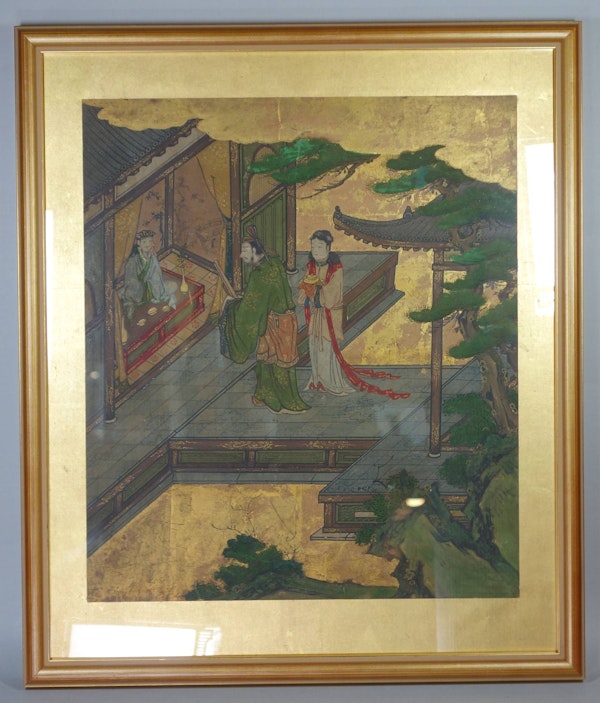Japanese Kano school painting, 17th century
Japanese Kano school painting, 17th century
POA
Description
Japanese Kano school painting, 17th century, in ink and polychrome colours against a gold leaf background, depicting Ding Lan serving a wooden statue of his father seated on a dais with offerings while his wife looks on with a further offering, all in a pavilion garden setting with pine and rockwork, the scene partly obscured by golden clouds.
Notes:
The themes and styles of Chinese art have had a signifiant influence on Japanese painting for hundreds of years, with genres including bird and flower studies, Buddhist religious paintings, inkwash landscapes, and, as seen here, depictions of traditional Confucian tales proving especially popular in medieval and early modern Japan. Despite thematic and stylistic similarities to Chinese models, Japanese paintings display a distinctly Japanese aesthetic. Mirroring this wider narrative of influence and innovation, the Kano school of painters, founded by Kano Masanobu in the 15th century, initially adhered closely to Chinese models, contributing to a revival of Chinese influence within Japanese medieval culture. However, over time the school developed a bolder, more distinctive style with firm outlines and brighter colours, as seen in this example. The Chinese text Quan xiang ershisi xiao shi xuan 全相二十孝詩選 (Selected verses on all aspects of the twenty-four filial exemplars) was compiled in the fourteenth century by the Yuan dynasty Confucian scholar Guo Jujing. The compilation of tales outlining the central Confucian concept of loyalty towards ones parents proved extremely influential across Asia and was translated into Japanese as Nijushiko 二十四孝 in the fifteenth or sixteenth century as well as becoming a popular theme in Japanese art. The tale depicted in this painting is called ke mu shi qin, 刻木事亲; 刻木事親 (He Carved Wooden Figures of His Parents to Serve Them) and tells the story of Ding Lan, who was orphaned at a young age. He missed his parents so much that he carved wooden figurines of them in order to continue loyally serving them and honouring them with offerings. Here he is portrayed with his wife in attendance; later in the story, his wife pricks one of the statues out of curiosity and is shocked when the statue starts to bleed. When he arrives home, Ding is so enraged at his wife's treatment of his honoured parents that he divorces her and chases her away.
| item details | |
|---|---|
| Material and Technique | Polychrome painting in inks and gold leaf |
| Origin | Japanese |
| Period | 17th Century |
| Dimensions | Dimensions of frame: 40cm. x 46.4cm. (15 3/4in. x 18 1/4in.) |
Product REF: Q707H


